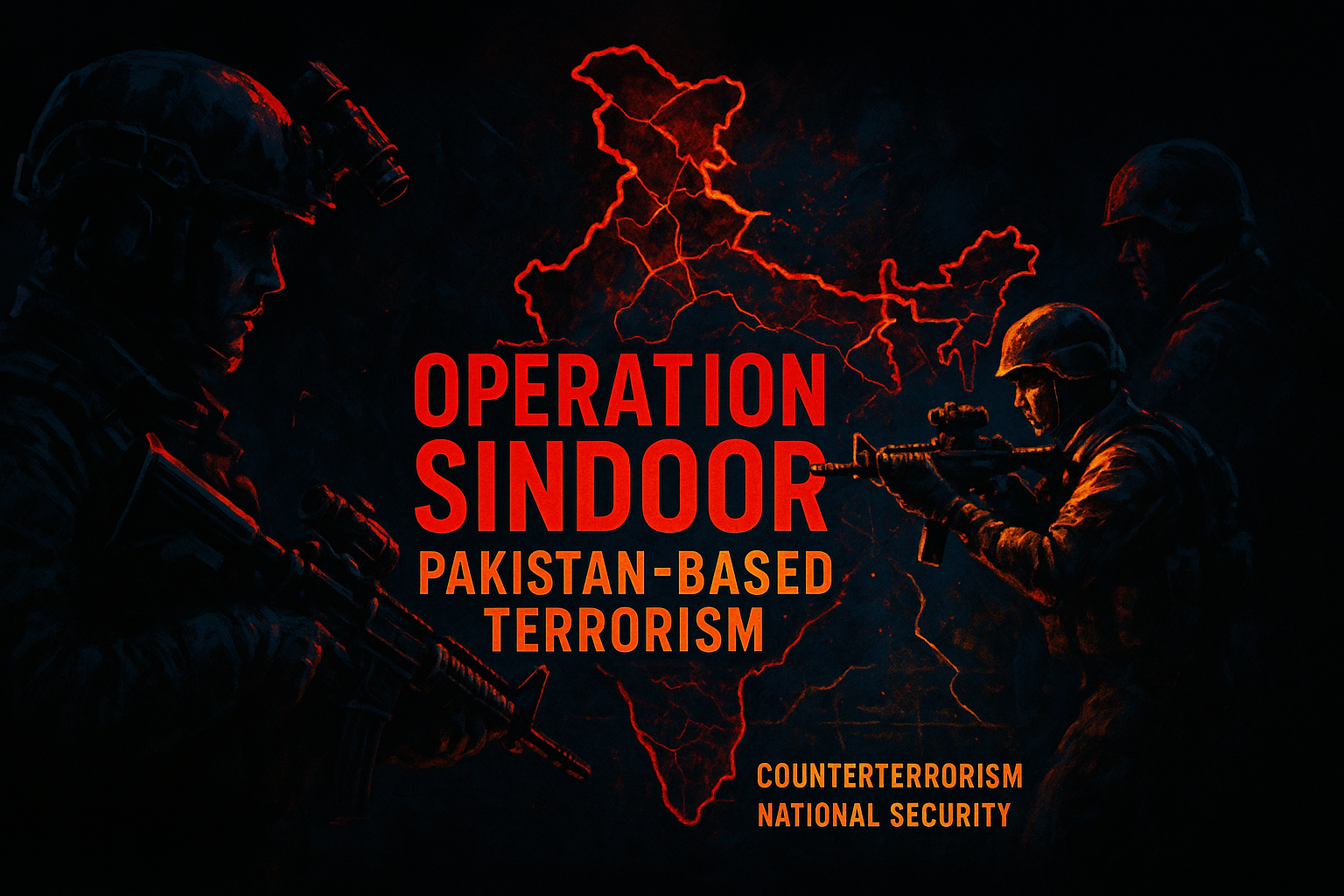Introduction
On May 7, 2025, India launched a strategic air operation named Operation Sindoor, targeting multiple terrorist camps in Pakistan-occupied Kashmir (PoK). The precision strikes came in response to a heinous terror attack in Pahalgam that killed 26 innocent civilians. By striking terror infrastructure across the border, India sent a bold message — that cross-border terrorism would not go unpunished.
Operation Sindoor has triggered significant discourse on the long-term consequences of such targeted military actions. This article explores the anticipated future impact of Operation Sindoor on Pakistan-sponsored terrorism, with a particular focus on deterrence, terror recruitment, international response, geopolitical shifts, and changes in regional defense postures.
1. Deterrence Through Precision: Changing the Cost-Benefit Equation
Disrupting the Terror Ecosystem
Operation Sindoor precisely struck known hideouts and training centers of groups like Lashkar-e-Taiba (LeT), Jaish-e-Mohammed (JeM), and The Resistance Front (TRF). These strikes demonstrated that Indian intelligence and strike capabilities could reach deep into enemy territory with minimal collateral damage.
By doing so, India effectively increased the cost of hosting and operating terrorist infrastructure in Pakistan.
Establishing a New Doctrine of Punitive Action
India’s action under Operation Sindoor represents a continuation — and evolution — of its doctrine of proactive deterrence, first seen in the 2016 surgical strikes and the 2019 Balakot air strike. However, Sindoor’s technological superiority and broader scale mark a new chapter.
Future Impact:
- Pakistan-based terror outfits will likely reassess the risks of establishing static training camps.
- Terror handlers may switch to more covert, decentralized models to avoid detection.
- Indian credibility on retaliatory strikes will act as a powerful deterrent, potentially preventing future cross-border operations.
2. Crippling the Logistics of Terror Networks
Destruction of Command and Control Centers
One of the most immediate impacts was the dismantling of communication and logistical hubs that enabled terrorist operations. These centers played a pivotal role in:
- Planning attacks in Indian territory
- Training recruits
- Transferring funds and arms
By hitting these nodes, Operation Sindoor disrupted operational continuity, forcing terrorist outfits to rely on ad hoc methods of coordination.
Impact on Recruitment Pipelines
The destruction of flagship camps—once viewed as symbols of strength—has a psychological impact on potential recruits. It sends a message that joining such groups no longer guarantees power or protection but could instead lead to premature death.
Future Impact:
- Recruitment for terror groups could decline in the short-to-medium term.
- The fear of Indian surveillance and strikes may push young radicals to reconsider involvement.
- Existing cadres may go underground or defect, fearing for their safety.
3. Strategic Isolation of Pakistan on the World Stage
Global Perception Shift
By showcasing high-resolution satellite images and pre- and post-strike drone visuals, India effectively built a credible global narrative that Operation Sindoor was an anti-terror operation, not an act of war.
While Pakistan labeled the strike as a violation of sovereignty, major powers like the U.S., France, Russia, and Australia sided with India’s right to self-defense.
Diplomatic Fallout for Pakistan
The repeated exposure of Pakistan’s terror infrastructure could have long-term diplomatic consequences:
- Financial sanctions or aid cuts from international bodies like the FATF or IMF
- Reduced legitimacy in multilateral forums such as the UN
- Loss of support even from traditional allies who wish to distance themselves from terrorism-related controversies
Future Impact:
- Pakistan may be forced to demonstrate real action against terror outfits operating from its soil.
- A growing number of countries may start treating Pakistan-based groups as global threats, tightening visa restrictions, funding flows, and travel for suspects.
- Islamabad might face stronger conditionalities on foreign loans and development aid.
4. Internal Political Pressure in Pakistan
Questioning the “Strategic Asset” Policy
For decades, elements within Pakistan’s establishment have viewed non-state actors as strategic assets against India and Afghanistan. However, Operation Sindoor’s precision strikes raised serious questions:
- Can these assets still operate with impunity?
- Are they worth the diplomatic and military cost?
As the operation laid bare Pakistan’s inability to protect even its well-established terror sanctuaries, internal fissures could emerge between the civilian government, military, and intelligence agencies.
Public Sentiment and Fear
Many Pakistani citizens are now aware that their proximity to terror camps makes them collateral targets in future Indian operations. There is growing unease about the long-term costs of harboring militants.
Future Impact:
- Pressure may rise on Pakistan’s government to disband known terror groups and reclaim sovereign control.
- Internal dissent could lead to reshaping Pakistan’s long-standing policies on cross-border terrorism.
- Civilians living near terror hotspots may begin resisting their presence, fearing for their lives and property.
5. Technological Shift in Warfare: The Terrorist Perspective
India’s Use of AI, Drones, and Surveillance
Operation Sindoor was not just an airstrike — it was a demonstration of modern warfighting techniques:
- AI-assisted target acquisition
- Real-time surveillance from UAVs
- Satellite intelligence sharing between Indian forces and allies
This has outdated the traditional terrorist playbook of hiding in mountains, forests, or civilian clusters.
Future Impact:
- Terror groups will have to spend more on encryption, concealment, and mobility — reducing operational efficiency.
- India’s technological dominance will force terrorists into reactive defense, limiting their ability to plan coordinated attacks.
- Pakistan’s intelligence agencies may struggle to keep up with these advancements, widening the capability gap.
6. Strengthening India’s Counter-Terror Narrative
Media and Psychological Impact
India used Operation Sindoor not just for military purposes but also to shape the information war. Through media outreach, social media campaigns, and international briefings, India controlled the post-operation narrative.
This helped:
- Project India as a responsible power fighting global terrorism
- Marginalize Pakistan’s narrative of victimhood
- Garner global sympathy and moral high ground
Boost in Public Morale and National Unity
Within India, the operation was hailed across political lines. It unified public opinion on national security and reminded citizens of the state’s resolve to protect them.
Future Impact:
- Consistent messaging will build long-term international goodwill.
- India’s security policy will enjoy greater bipartisan support, even in future military decisions.
- Civil society will become more alert and supportive of counter-terror operations.
7. Regional Security Realignment
Impact on Other Terror-Prone Regions
Pakistan is not the only state harboring or dealing with terrorist elements. Other nations in the region — including Afghanistan, Myanmar, and Iran — are watching closely.
Operation Sindoor may encourage:
- Similar pre-emptive doctrines in South and Southeast Asia
- Collaborative intelligence sharing among terror-affected nations
- Increased regional cooperation in counter-terrorism
Pakistan’s Tactical Shifts
Fearing more such operations, Pakistan may:
- Move camps deeper into civilian zones or remote areas
- Increase camouflage and underground bunkers
- Delegate more responsibilities to proxy groups like TRF, avoiding direct ties
Future Impact:
- Indian forces may need to develop advanced urban warfare doctrines for future actions.
- Pakistan’s new tactics may be more difficult to detect but less coordinated, reducing effectiveness.
8. Long-Term Military and Policy Shifts in India
Defensive Fortification
India will likely:
- Strengthen border surveillance using drones and satellites
- Expand paramilitary deployment in critical regions like Jammu, Kashmir, and Ladakh
- Improve readiness for chemical/biological threats, anticipating desperate terrorist retaliation
Legal and Strategic Policy Changes
Post-Operation Sindoor, India may:
- Amend defense laws for quicker response to cross-border threats
- Expand the role of agencies like RAW and NTRO in joint strike planning
- Propose regional anti-terrorism conventions in SAARC or BIMSTEC
Future Impact:
- A more robust, integrated defense framework
- Faster decision-making for future strikes
- Better international legal defense against Pakistani counter-narratives
Conclusion
Operation Sindoor has not only punished terror actors but changed the very landscape in which terrorism survives. It represents a tectonic shift in how India deals with state-sponsored terrorism — from defensive posturing to offensive action grounded in legality, precision, and intelligence.
Its impact on Pakistan-based terrorism is expected to be long-lasting and multidimensional:
- Operational disruption of terror networks
- Diplomatic isolation of Pakistan
- Fear-induced decline in radical recruitment
- Technological setbacks to conventional terror methods
- Internal and regional rethinking of support for proxy warfare
While it would be unrealistic to claim that one operation can eliminate terrorism, Operation Sindoor has undoubtedly made the ground slippery for its propagators. The message is clear: India will not wait for blood to be spilled before acting. And for those who build castles of terror, even the sky is not safe anymore.




